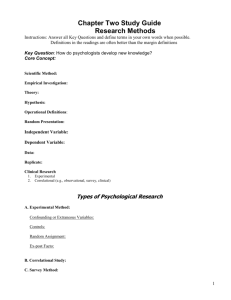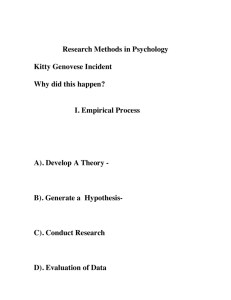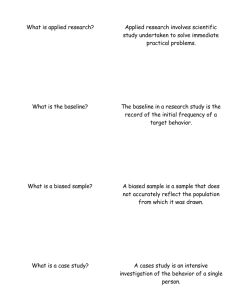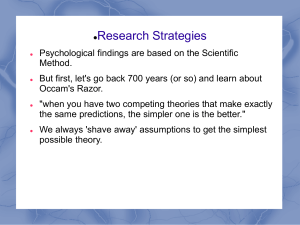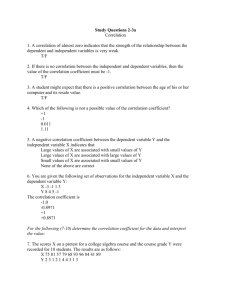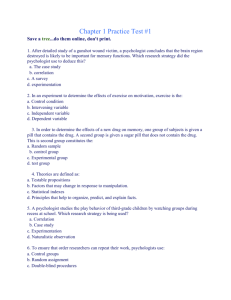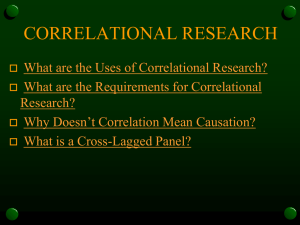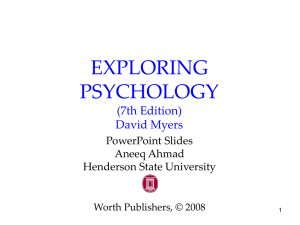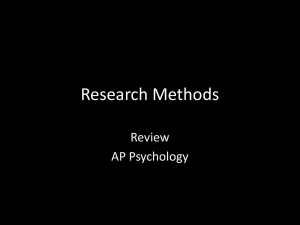Unit 2 Reading Guide
advertisement
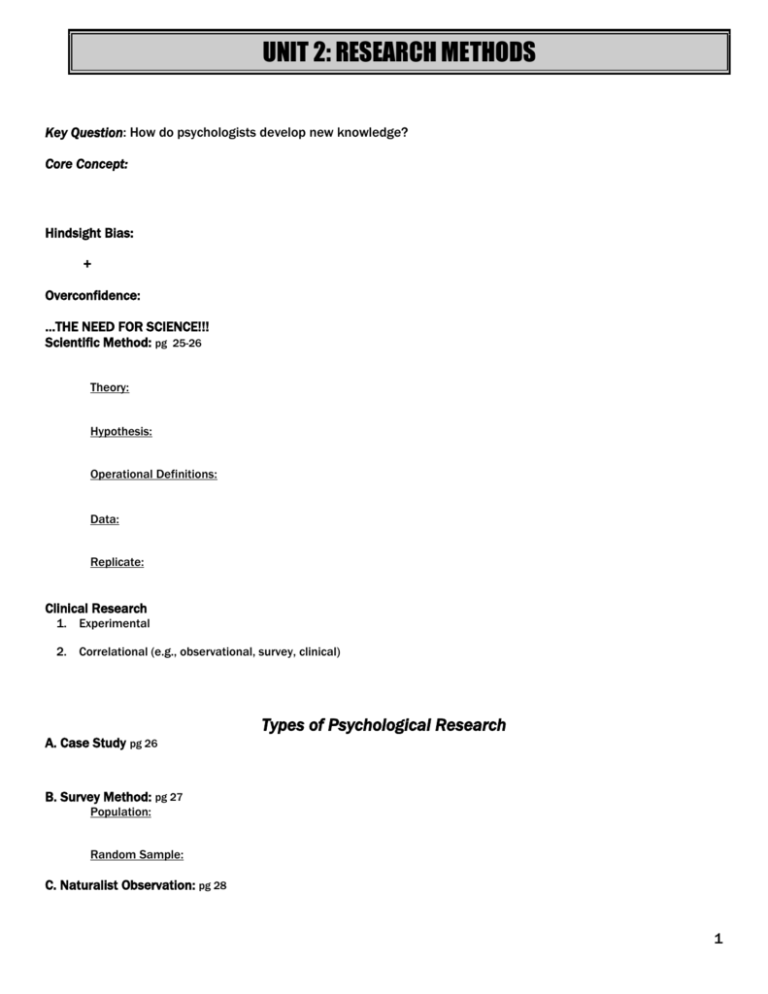
UNIT 2: RESEARCH METHODS Key Question: How do psychologists develop new knowledge? Core Concept: Hindsight Bias: + Overconfidence: …THE NEED FOR SCIENCE!!! Scientific Method: pg 25-26 Theory: Hypothesis: Operational Definitions: Data: Replicate: Clinical Research 1. Experimental 2. Correlational (e.g., observational, survey, clinical) Types of Psychological Research A. Case Study pg 26 B. Survey Method: pg 27 Population: Random Sample: C. Naturalist Observation: pg 28 1 D. Correlational Study: pg 29-33 Correlation: Correlation Coefficient: Scatterplots: Illusory Correlation: CORRELATION DOES NOT EQUAL CAUSATION!!!! E. Experimental Method: pg 34-36 Random assignment: Double blind procedure: Placebo effect: Experimental group: Control group: Independent variable: Confounding or Extraneous Variables: Dependent variable: F. Longitudinal Study: G. Cross-sectional Study: H. Cohort-sequential Study: Personal Bias: Expectancy Bias: Single-Blind Study: 2 STATISTICS Descriptive and Inferential pg 37 Key Question: How Do We Make Sense Of The Data? Core Concept: A. Descriptively … B. Inferentially … Measures of Central Tendency…or averages pg 36-38 The central point around which the scores seem to cluster Mode: Mean: Median: Mean, Median, Mode All are descriptive statistics and measures of central tendency Measures of Variation pg 39-40 Range: Standard Deviation: Normal Distribution (curve): Statistical Significance: Ethics In Research pg 44-46 Deception: Good and Bad? Animal Studies 3 Notes Five Steps of the Scientific Method 1. Develop a hypothesis 2. Perform a controlled test 3. Gather objective data 4. Analyze the results 5. Publish, criticize, and REPLICATE the results The independent variable is the thing that someone actively controls/changes; while the dependent variable is the thing that changes as a result. For example……… --In a study of how different dosages of a drug are related to the severity of symptoms of a disease, a measure of the severity of the symptoms of the disease is a dependent variable. --The administration of the drug in specified doses is the independent variable. --Researcher will compare the different values of the dependent variable (severity of the symptoms) and attempt to draw a conclusion. The Experimental Method Basic Purpose: to explore cause and effect How Conducted: manipulate one or more factors, use random assignment What is Manipulated?: the independent variables Weaknesses: Sometimes not feasible Results may not generalize to other contexts Not ethical to manipulate certain variables Correlational Study Basic Purpose: To detect naturally occurring relationships To assess how well one variable predicts another How Conducted: compute statistical association, sometimes among survey responses What is Manipulated?: nothing Weaknesses: does not specify cause and effect ************************ Other Terms to Know ************************. Pseudoscience: fake science…has not survived trial by the scientific method Experimental group: Those in the study that get the special treatment, such as a new drug Control group: Those in the study that get the placebo Quantified: Concepts that are measured and expressed as numbers. Often presented in graph form. This type of data is generally obtained when you conduct experimental research. False Consensus Effect: The tendency to overestimate others’ agreement with us. Example: Vegetarians will think more people are vegetarians that will meat eaters. Scatterplots: A graphed cluster of dots, each of which represents the values of two variables. --The slope of the points suggests the direction of the relationship between the two variables. --The amount of scatter suggests the strength of the correlation Correlation Coefficient: A number between –1 and +1 expressing a degree of relationship between two variables 1. If people have high scores on one variable also have high scores on another, the correlation is positive The Correlation Coefficient is also positive ex: +.03 2. If people have high scores on one variable, but low on another, the correlation is negative The Correlation Coefficient is also negative…(less than 0) 3. Zero means there is no relationship between scores **Does NOT tell about cause and effect Simply gives information on the direction and strength of the relationship** Significant Difference: Psychologists accept a difference between groups to be ‘real’ or significant when the probability that in might be due to chance is less than 5 in 100 4 5
